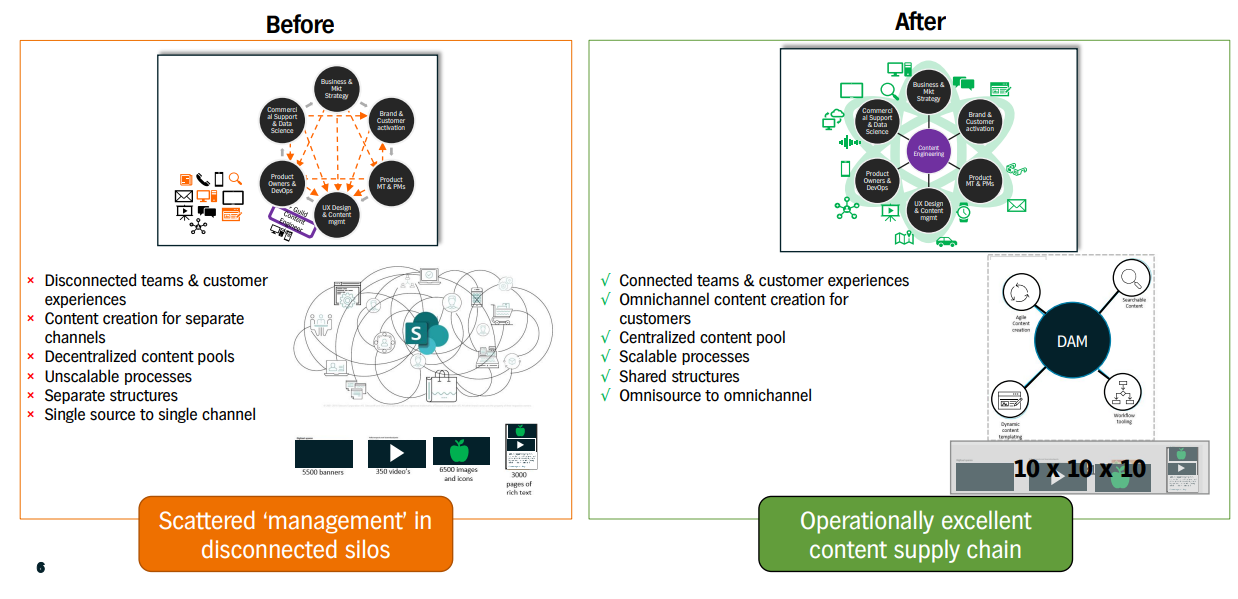By Janus Boye
Rafaela Ellensburg works as Content Engineering Consultant at Dutch retailer Albert Heijn
Dutch retailer Albert Heijn is probably the first company in the Netherlands to establish Content Engineering as a functional expertise.
In her role as Content Engineering Consultant at the retailer, Rafaela Ellensburg is the first and still only one working with this focus. This year she’s working hard to make the leap from content-as-a-liability to content-as-a-service, and she’s learned quite a bit along the way.
In a recent member call, Rafaela shared her lessons learned, her holistic view on content and why structured content is the basis for scalable digital customer experiences.
Below you’ll find notes from the call and towards the end you can download the slides. Rafaela started the call with her answer to one of my favorite questions: What’s the problem we are trying to solve?
Introducing content engineering
Customers expect relevant content always and everywhere, but as Rafaela said, at Albert Heijn the problem was a big one:
“With 23.000+ static creative content assets created each year, we were not equipped to scale our omnichannel customer experience sustainably”
This number might sound high, but includes pages, banners, rich content, images and more that are used as a part of their omnichannel experience. It’s far from just this one Dutch retailer which is facing this problem.
Content engineering is a new discipline that transforms content into valuable assets, that you can treat just like products, to enable relevant omnichannel customer experiences in an operationally efficient way
Also content engineering operates on the cutting edge of product, data & technology. It works with the goal to provide a relevant customer experience, which tends to be complicated by an expansion of channels and increased volume of content. This again leads to increased costs, effort and time for content creation, which is not scalable.
That’s the problem, content engineering aims to solve. So how do you address it?
Content engineering is relevant across the organisation: Earlier this year Rafaela gave an internal talk on content engineering in front of an audience with product directors, managers, owners and UX designers
A foundation for scalable digital CX stands on 4 pillars
The MarTech vision at Albert Heijn is simple: Each customer getting the right message, at the right moment, via the right channel, for the most relevant food experience.
Rafaela called content engineering an operational enabler and highlighted the 4 pillars to make it possible. For each she shared some helpful before and after illustrations.
1.Structured & modular content
In this pillar they transform content assets into a flexible form that can be (re)assembled at scale. As shown below, you can see the difference in before and after. Before they had images that were too small for a banner and too big for the app. Unportable without metadata and really a single channel approach. Now, they have modular elements which adapt to views and channels, fits multiple components, portable with metadata and create once, publish everywhere.
2. Centralised content management
Here they connect teams and processes, to free content from internal silos and disconnected customer experiences.
Before they had scattered ‘management’ in disconnected silos with disconnected teams, content creation for separate channels, unscalable processes. Now, a much better content supply chain with connected teams, omnichannel content creation for customers, a centralised content pool and shared structures.
3. Automated content configuration & dynamic publication for scalable visibility
Here they streamline content as a service through the digital landscape. Before they had manual configuration and static publications. Now they have automated content configuration and dynamic publications.
4. Smart content delivery for relevance
In this final pillar, they enable smart content interactions to deliver more personal customer experiences across multiple channels.
Before they had generic, single channel experiences, which they have now transformed to relevant, omnichannel customer experiences.
Where to start your journey with content engineering
To really make content engineering this operational enabler, Rafaela recommended that you start by building expertise internally. Educate stakeholders, evaluate new capabilities, experiment with prototypes and establish shared principles and definitions.
Furthermore, she suggested to reverse engineer what you already have towards the future. Say you start with a team and a CMS, and then look towards the future:
You probably already have customer data, services and IDs
There’s probably room for improvement when it comes to aligned processes & teams, shared rules & governance
Rafaela shared a timeline as a way to plan your initiatives, different in scope and complexity, as you take the next steps on your journey.
Keep the goal in mind: Decrease the amount of manual work to scale your experience.
Good luck and in the spirit of Rafaela learning journey: Do share your comments and feedback!
Learn more about content engineering at Albert Heijn
Rafaela has also shared more background in this post on the need to approach content differently: A holistic approach to content as foundation for your omnichannel strategy.
You can also download the slides (PDF).






